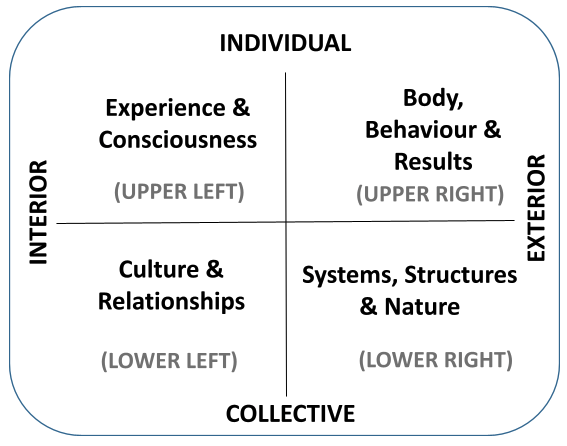INTEGRAL COACHING IN SPORTS

By Nuno Matos, Ph.D.
Master Integral Coach
- Mindset is not the one and most important performance asset -
We all know that an athlete’s mindset is highly important, but I hear and read a lot from mental coaches, athletes and the like, recommending that athletes strengthen their mindset. “Work on your mindset. It’s everything!” “All you need is a strong mindset! “If you focus on your mindset, you will make it, it’s the most important thing!”
Mindset is definitely important, don’t get me wrong. But it’s not the one and only. That is all I am trying to convey here, and to explain my point I will use Ken Wilber’s Four- Quadrants model.
According to Ken Wilber, and to my experience as a Master Integral Coach,TM who has been coaching athletes for over 8 years now, focusing on one quadrant only is going to leave out very important aspects that also contribute to the impact of athletes’ performance. Considering the figure below, you can see that these four main perspectives are always present, and to paraphrase Ken Wilber, they tetra-emerge on a moment-to-moment basis.
In brief, figure 1 below basically refers to the inside and outside of the individual and the collective. The upper left (UL) quadrant refers to the inner experience and consciousness of the individual: what is meaningful to me, what I am thinking and feeling, my beliefs about something, my intentions, and my subjective truth.
The upper right (UR) quadrant focuses on what is observable and able to be measured, i.e., the individual’s body and behavior: my actions, what I say, “how I go”, the tensions and energy I carry, the results I obtain.
The lower left (LL) quadrant is the interior perspective of the collective: the culture and relationships in a group, the values shared, rules that don’t need to be spoken, a sense of being part of a group (or excluded from).
Finally, the lower right (LR) quadrant that focuses on the structures and systems that support us: how things come together, the parts that compose the system, the processes, structures and systems that enable us to make measurements, analysis and evaluations. Or simply, how I fit in the system.

Figure 1 – The four quadrants. We can take four perspectives of the same phenomenon we are looking at.
When we speak about an athlete’s mindset we are referring to what happens in the mind of the athlete, more specifically what is the “narrative” that happens when the athlete is under pressure – and here we are taking a UL quadrant perspective. In fact, it is when the athlete is under pressure that one can access the athlete’s mindset.
Normally our most embedded behaviors will come out in “all their truth” when we find ourselves under pressure. In other words, you want to know the mindset of an athlete, put him or her under pressure and then ask what narrative was going on in their minds. What were they telling themselves? What was really at risk?
The mindset is an aspect of the UL quadrant because it is subjective and specific to each individual. The manifestation of the athlete’s mindset is what we see in the sports field, i.e., how he behaves, how he or she “goes” about dealing with the pressure – manifestation of the UR quadrant perspective. Since “how he goes” is no longer subjective, but an objective aspect of the athlete’s mindset, here I look for what the athlete does and says, the energy in the athlete’s body and the results he obtains.
Let’s say the athlete’s mindset is like a “killer mindset,” meaning the athlete will keep going no matter what (not giving up is an extremely important value that the athlete orients in the UL quadrant).
By focusing only on the UL quadrant, the athlete may not consider the impact that the load he is engaged in is having on his physiological adaptations and he may easily bypass that, putting at risk his physical performance and the results he obtains.
But because he does not consider his body energy levels and is likely to ignore fatigue - remember, his mindset is one of striving and never giving up – he will simply continue until something goes wrong. This can take many forms like overtraining, burnout, injury, depression, etc. This is “dangerous” and I know of no athlete that looks for this outcome.
If this athlete has little capacity to connect to the body and feel, then all the fatigue and body’s adaptation to training load will pass right “over his head”. He will just want to continue training and be motivated to do it: “fatigue and putting a stop to training is only for the weak.”
Let’s continue considering the killer mindset, but now let’s take the LL quadrant perspective. Imagine this athlete doesn’t pay much attention to the people that surround him and that can offer support, or simply that his relationship with the coach is in a bit of a mess. This athlete has little capacity for expressing his fears and insecurities to his coach, and so he never speaks his truth, including the fact that at times he is feeling shattered, and even though there is an intuitive feeling that taking a break would be positive, he just keeps going.
On top of that, this coach has a really bad attitude that, albeit aligned with the athlete’s mindset (and the culture of the club where he trains), leads him to hide his feelings and what he thinks. When/if he disagrees with what the coach is asking of him, he will just stay in silence and “move on”.
A lack of support from the coach and the people around the athlete can leave the athlete feeling powerless, lonely and not understood. But hey! This athlete has a killer mindset so, once again he won’t pay attention to these aspects and nuances… and he will continue.
Finally we reach the LR quadrant, where we can look at the system that supports (or not) the athlete. Imagine that this athlete’s club actually has some financial problems, and the facilities for training are not in the best conditions, leaving the athlete vulnerable to injuries or for falling ill (cold drafts, no hot water in changing rooms, etc.).
Adding to this, the coach doesn’t keep a good record of the athlete’s training responses over the season, which consequently messes up the delivery of training sessions and training load, impacting the performances that both athlete and coach are looking for. So, apart from the already high training load the athlete is exposed to, he lacks good training conditions (vulnerability to injuries), lacks good planning from the coach, and is vulnerable to falling ill more easily.
This is a recipe for a lot of things to go wrong. In essence – a recipe for disaster!
Ultimately, and since this is the most important thing for the athlete, his performance will suffer. But again, that’s if we only take the UR quadrant perspective. If we look at the UL quadrant perspective in this situation, we will find that the athlete will become so disappointed that it could potentially lead to depression.
In the LL quadrant he could blame the coach for the lack of performance, and the coach could blame the athlete for a lack of commitment and mental strength, eventually leading to a broken relationship.
In the UR quadrant we can blend all these pieces together and have a much better understanding of why things happened the way they did.
One final thing I would like to add relates to the fact that each human being has a primary and a secondary quadrant orientation. For example, I orient primarily from the UR quadrant (I tend to look quickly for what I have to do and the results I will obtain), and then I look at the system around me (LR quadrant is my second orienting quadrant) and how things come together.
Not everyone will orient from the same quadrant when looking at the world; in this case, when looking at performance. When I am coaching athletes, right from the first conversation we have, I am looking to see what quadrant he or she uses to orient their training and performance.
This means that not only can I understand better the reality the athlete lives in and where he/she is coming from (since I am looking as the athlete), but I also get access to what is “being left out” by the athlete. By “being left out” I mean the perspectives (or quadrants) that the athlete is not considering and therefore, contribute to his/her partial approach to the challenge.
With an integral coaching program, I can become much more specific and better oriented in terms of knowing where this athlete needs to grow and develop capacity.
I hope that with this article, athletes, sports coaches and sports parents can gain a more complete view of what influences sports performance and that, even though having a strong mindset is extremely important, it is not everything.
One needs to account for other factors, aspects, and dimensions of consciousness if we are to elevate sport to a higher level of consciousness, and if we are to produce better athletes who are also more evolved human beings.
Optimize Your SELF to Impact the WORLD
----------
Join the EVO Collective and access to our Newsletter, LIVE Monthly Masters Calls, and the EVO Masters Library. For FREE.
We hate SPAM. We will never sell your information, for any reason.


